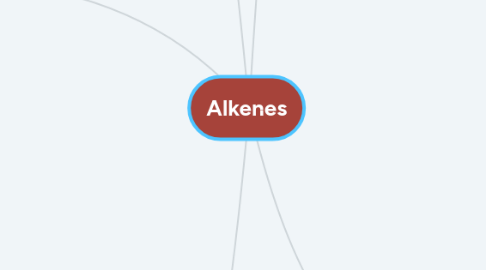
1. Stereoisomerism
1.1. Same molecular and structural formula
1.2. Different spatial arrangements of bonds or atom
1.3. Cis-Trans isomerism
2. Polymerization
2.1. Two or more molecules of a simple compound (monomer) joins to form a long chain (polymer)
2.2. Condition
2.2.1. Catalyst
2.2.2. High Temperature
2.2.3. Hign Pressure
2.3. Addition Polymerization
2.3.1. When the polymerization has carbon-carbon double bond
2.4. Polymer Example
2.4.1. Usage
2.4.1.1. Polyethene (PE)
2.4.1.1.1. Plastic Bag
2.4.1.1.2. Bowls
2.4.1.1.3. Buckets
2.4.1.1.4. Trays
2.4.1.1.5. Crates
2.4.1.2. Polychloroethene (PVC)
2.4.1.2.1. Electrical Insulation
2.4.1.2.2. Waterproof Plastic
2.4.1.2.3. Plastic Papers
2.4.1.3. Polystyrene
2.4.1.3.1. Electrical Insulation
2.4.1.3.2. Packaging Material
2.4.1.4. Polypropene
2.4.1.4.1. Rope
2.4.1.4.2. Packaging
2.4.1.4.3. Plastic Pipes
2.4.1.4.4. Chairs
2.4.1.4.5. Wrapping Film
3. Physical properties
3.1. Boling point and melting point increase when carbon atoms increase
3.1.1. The size of the molecue and no. of electron increase
3.1.2. The strength of VDW force increase
3.1.3. Slightly lower than corresponding alkanes because of their smaller size
3.1.4. Cis-Trans Comparison
3.1.4.1. Boiling Point: Cis but-2-ene (polar) (4°C) >Trans-but-2-ene (non-polar)(1°C)
3.1.4.2. Melting Point: Trans-but-2-ene (non-polar)(-106°C) > Cis but-2-ene (polar) (-134°C)
3.2. Not soluble in water but soluble in organic solvent
3.2.1. Alkene is non-polar
3.2.2. Unable to form strong interaction with polar subtances such as water
4. Introduction
4.1. Unsaturated hydrocarbon, CnH2n
4.2. Double bond
4.3. sp2-hybridization
5. Chemical properties
5.1. More reactive than alkanes
5.1.1. Presence of Pi bonds
5.1.2. The Pi electron in the saturated alkenes are converted to saturated alkanes
5.2. Reaction
5.2.1. Combustion
5.2.1.1. Burn in oxygen with soothier flames compared to alkanes
5.2.1.2. General equation: CxHy +[x+ (y/4)] O2 ——>xCO2 + (y/2)H20
5.2.2. Addition Reaction
5.2.2.1. Halogenation
5.2.2.1.1. Reagent: Cl2 (or Br2) in CCl4 (organic solvent)
5.2.2.1.2. Condition: Room temperature
5.2.2.1.3. Product: Chloroalkanes (or Bromoalkanes)(Haloalkanes)
5.2.2.1.4. Observation
5.2.2.1.5. Test for unsaturation
5.2.2.2. Hydrogenation
5.2.2.2.1. Reagent: Hydrogen (H2)
5.2.2.2.2. Condition: Heat (140-180°C at 10 atm) in the presence of Ni catalyst
5.2.2.2.3. Alternative condition: Passed over Pt/Pd catalyst in room temperature
5.2.2.2.4. Product: Alkanes
5.2.2.2.5. Important in the "hardening" of vegetable and animals oils to roduce solid fats use to make margerine
5.2.2.3. Hydration
5.2.2.3.1. Reagent: Steam
5.2.2.3.2. Condition: Heat (300°C at 70 atm) in the presence of H3PO4 catalyst
5.2.2.3.3. Alternative condition: Conc. H2SO4 at 170°C followed by hydrolysis
5.2.2.3.4. Product: Alcohols
5.2.2.3.5. Unsymmetrical alkenes follow Markonikoff's rule
5.2.2.4. Hydrohalogenation
5.2.2.4.1. Reagent: Hydrogen Halides (HX)(X= F,Cl,Br,I)
5.2.2.4.2. Condition: Room temperature
5.2.2.4.3. Product:Haloalkanes
5.2.2.4.4. Unsymmetrical alkenes follow Markonikoff's rule
5.2.3. Oxidation
5.2.3.1. Mild oxidation
5.2.3.1.1. Condition: Colld, Diluted (acidified or alkaline) KMnO4
5.2.3.1.2. Product: Diols
5.2.3.1.3. Observation
5.2.3.1.4. Useful test for unsaturation (carbon double bond)
5.2.3.2. Strong Oxidation
5.2.3.2.1. Condition: Hot & acidified conc. KMnO4
5.2.3.2.2. Product: Carboxylic Acid, Ketone, Carbon Dioxide & H20
5.2.3.2.3. Observation
5.2.3.2.4. Use to determine the position of alkene linkages in larger molecule
5.2.4. Markonikoff's rule
5.2.4.1. In the addition of H-X unsymmetrical alkene
5.2.4.2. H atome attaches itself to the carbon with greater number of H atoms
5.2.4.3. Major and Minor product
